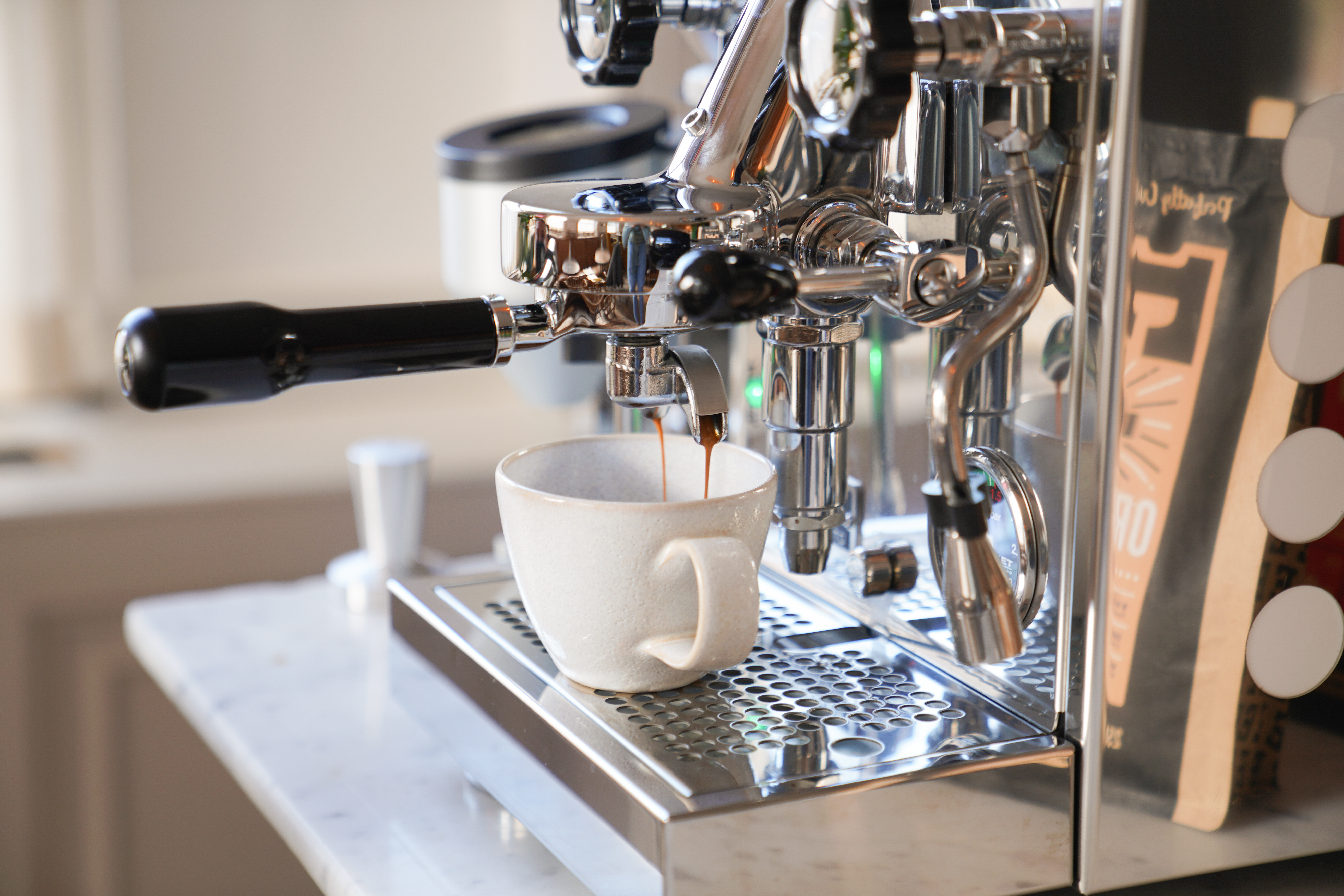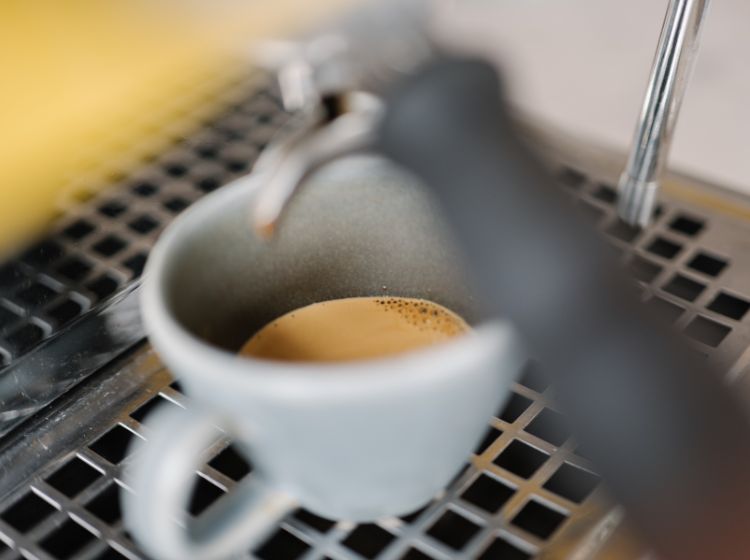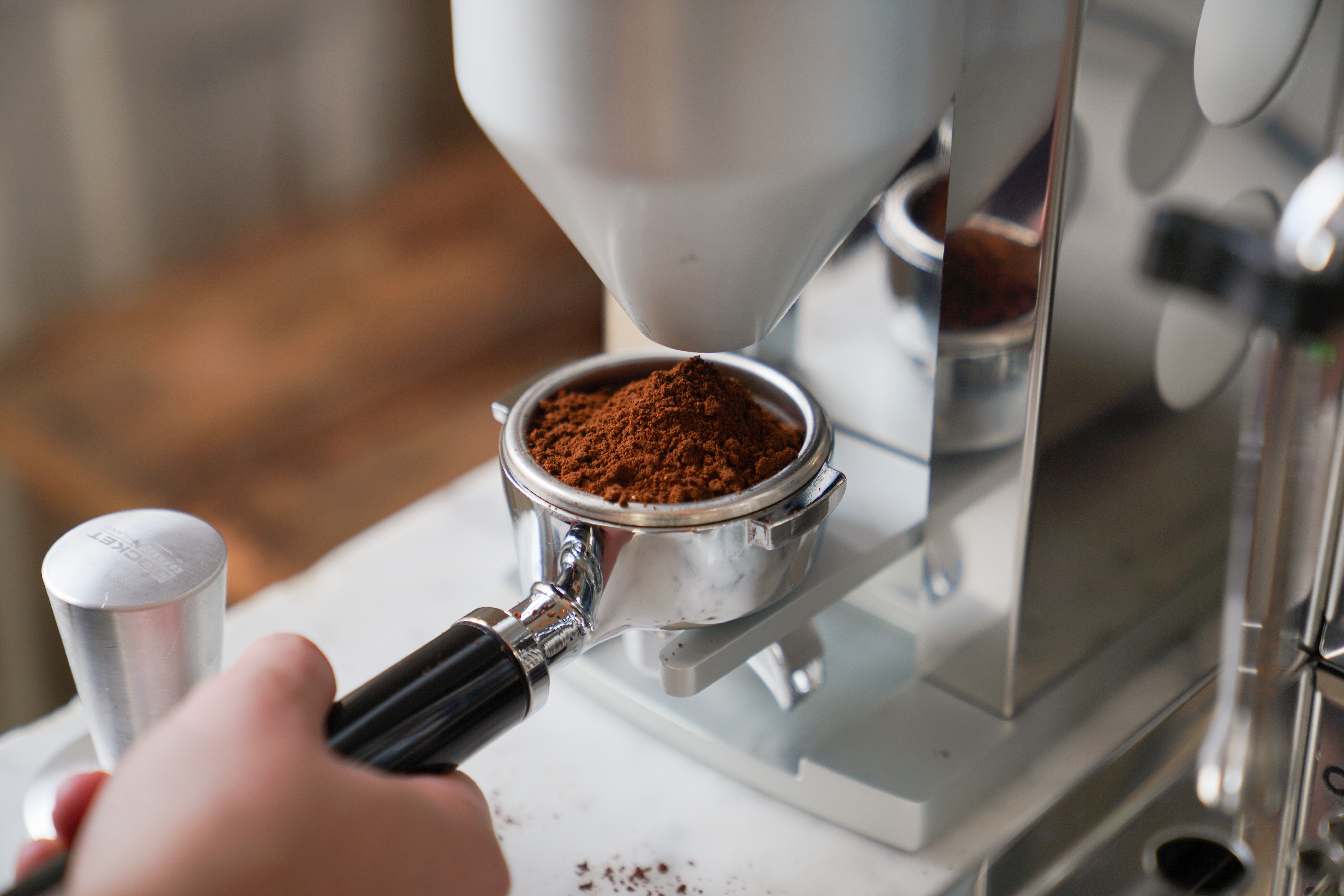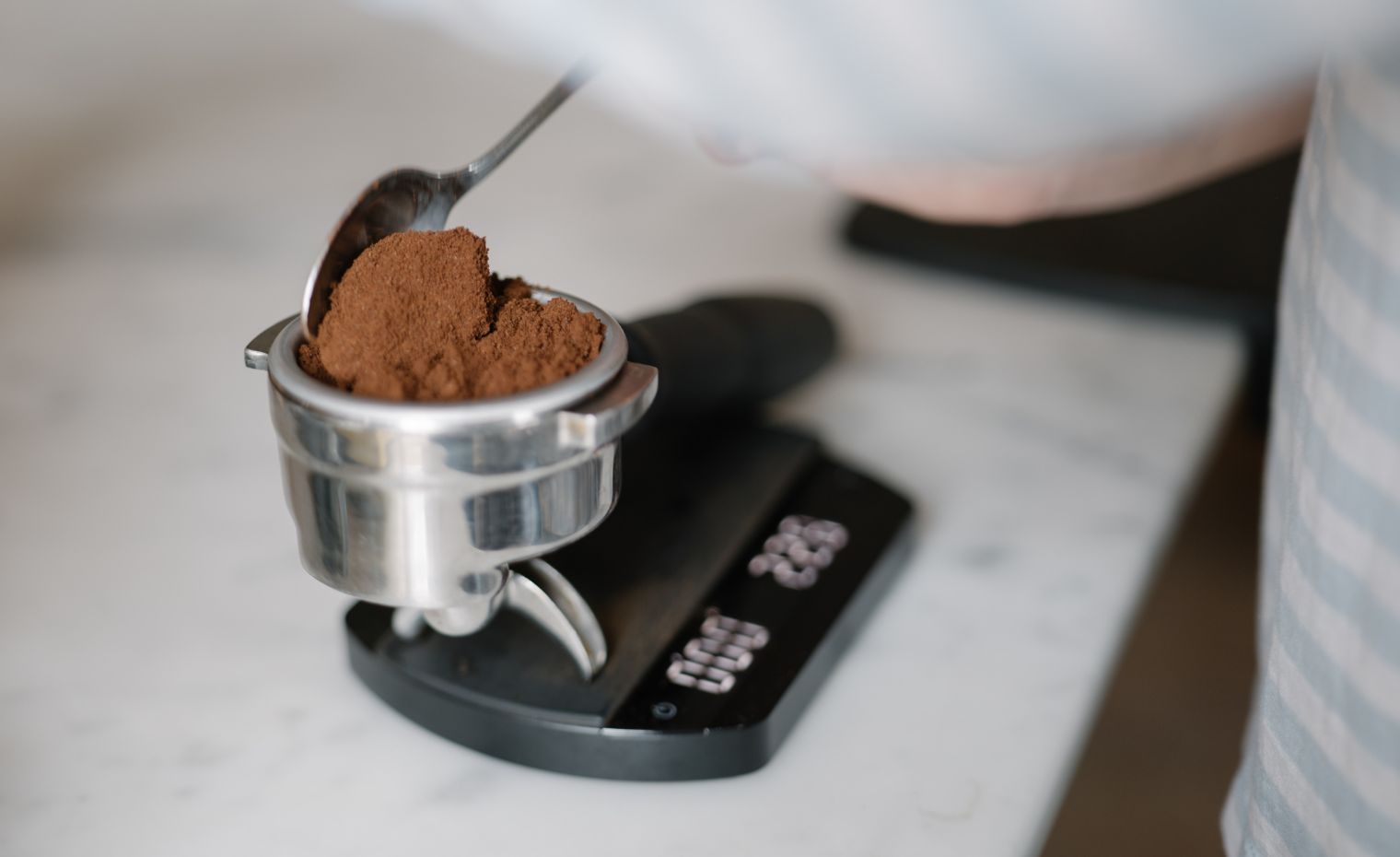
How to choose the best home espresso machine
So you've decided to invest in an espresso machine to help you make incredible barista-style coffee at home. There’s a huge choice of espresso machines out there for the budding home barista but when it comes to researching, where do you start?
In this guide we outline
- Top 3 things you need to make good quality espresso at home
- A full kit list of home barista equipment
- Key things to look for when researching and buying home espresso equipment such as espresso machines and grinders.
- Our recommendations for espresso machines, including a comparison between domestic espresso machines from La Marzocco and Rocket Espresso.
- Recommended home barista accessories.
- FAQs and jargon-busters for espresso machines.

What are the top 3 things you need to make epic espresso?
When it comes to making incredible-tasting espresso, we like to focus on 3 things; accuracy, quality and freshness.
Accuracy
Precision is a really important part of making better coffee - especially with espresso. A cup of coffee is made through a process of extraction.
The caffeine and coffee being extracted from ground beans in to water. To make a good tasting cup of coffee, you need to get this extraction just right.
You need the right ratio of coffee to water, the right temperature, the right pressure, the right grind size and the right amount of contact time between the coffee and water.
When it comes to coffee equipment, more accuracy and precision means more control over your coffee and the end result. Your machine should be consistent in its performance, particularly in terms of pressure and thermal stability. This means you can focus on making adjustments to individual variables to get your coffee tasting just right.
Quality
To make great tasting coffee you need good quality beans and good quality equipment.
The coffee we roast at Extract Coffee Roasters is what’s known as speciality grade. That means it’s been produced with care from crop to cup. The Speciality Coffee Association have a nice explanation of that in this article: What is Speciality Coffee?.
At Extract, our coffees are ethically sourced and are fully traceable. Here in the roastery, the coffees are carefully roasted by hand in cast-iron Probat roasters, a huge amount of care goes into crafting the product at every stage.
To make top quality espresso, the equipment you use should also be good quality - well built, durable and precise.
We favour equipment which gives us more accuracy over the weight of our coffee and water, thermal stability when it comes to temperature control and accurate timers.
These features will help you get more consistent results when it comes to making espresso at home.
As well as buying good quality equipment, you should make sure you’re keeping it in good nick. Keep it clean and well maintained for better tasting, more consistent coffee.
Freshness
Our coffee should arrive with you within 3 weeks of being roasted and we recommend consuming coffee within 3 months of roast date.
At Extract our coffee is packed in nitrogen-flushed bags. This prolongs the lifespan of the coffee and means it arrives with you at peak freshness.
It’s important to remember that with espresso, coffee can be too fresh. It needs to time to rest and de-gas after roasting. If you put coffee which is too fresh through your espresso machine you’ll get a bubbly shot of espresso, an uneven extraction and a poor tasting coffee.
Coffee starts to lose flavour within about 20 minutes of being ground, so the number one thing you can do to improve flavour is to buy whole beans and grind beans as you need them.
This means a decent coffee grinder is a worthwhile investment.
If you’d like more tips on coffee freshness, check out our blog post: How to keep coffee fresher for longer.
For more tips on making incredible tasting espresso at home, check out our espresso brew guide.

What equipment do you need to make epic espresso at home?
Making really good espresso at home does come with some investment. There are the big pieces of kit you need (espresso machine) but also a range of home-barista accessories.
Here is ultimate home barista coffee kit list:
- Espresso machine
- Coffee grinder
- Your favourite Extract coffee
- Coffee Scales
- Coffee Tamper
- Coffee Tamp mat
- Coffee knock box (somewhere to put your spent coffee grinds)
- Water filter
- Microfibre cloth
- Espresso machine cleaner and cleaning tool
So, it's no surprise that the espresso machine ends up taking up an entire corner or worktop in the kitchen with a drawer or cupboard dedicated to barista accessories. Many home baristas also keep their info cards as a record of all the coffees they've tried and their favourite coffees.
If you're into coffee (and if you've got this far down the guide we're guessing you really are) then curating your perfect home barista set up is a lot of fun. We love seeing your home set-ups so please fire us over a picture or tag us on instagram @extractcoffee.

What are the top things to look out for when researching espresso machines?
There are lots of machines on the market and a huge difference in price and quality.
These are the top features to look for in a home espresso machine:
- Thermal-stability. Better thermal stability will result in a more even extraction and more consistent coffee. So this one's important. Features like PID will help your machine regulate it's temperature and improves thermal stability.
- Shot-timer. It's not essential. But it's so helpful when it comes to accuracy and precision. We find that a built-in shot timer increases your awareness of your shot time and encourages more accuracy. All resulting in better tasting coffee.
- Pressure. Espresso relies on high pressure, so your machine needs to be able to deliver this to get a good extraction. You want to aim for 9-bar pressure. Features such as whether a machine has a rotary or a vibration pump are an indicator of the pressure and consistency of pressure that your machine can deliver.
- Boiler. Single boiler? Or dual boiler (one for milk and one for espresso). Some machines, such as the Rocket Appartamento and Giotto Cronometro R have a heat exchange unit, which means that they are able to simultaneously make coffee and steam milk, even though they have just one boiler.
- Weight. How heavy will the machine be to move? Is the machine weight OK on your worktop?
- Warranty & support. What happens if something goes wrong? How much support is there for set up? All of the domestic espresso machines sold by Extract come fully supported and include a 2 hour home barista workshop at Extract London or Extract Bristol.
- Design. There are some beautiful espresso machines out there and a whole range of customisation options. It's a big investment and should be a stylish addition to your kitchen or office.

What are the best espresso machines for making coffee at home?
These are, we think, the closes that you can get to commercial-grade espresso from the comfort of your own kitchen.
The home espresso machines that we sell and recommend are:
- Rocket Espresso Appartamento
- Rocket Espresso Giotto Cronomtetro R
- La Marzocco Linea Mini
- La Marzocco GS3
These are all available to buy over on the Extract Coffee Roasters webshop. You can also see a side-by-side comparison of these machines in the table below.
| Rocket Appartamento | Rocket Giotto | La Marzocco Linea Mini | La Marzocco GS3 | |
|---|---|---|---|---|
| Dimensions WxDxH | 274x425x360 mm | 335x420x400 mm | 357x453x377 mm | 400x530x355 mm |
| Weight | 20.4 KG | 27.8 KG | 30KG | 34.5KG |
| Power | 1350W / 6 Amps | 1350W / 6 Amps | 2200W / 10 Amps | 2860W / 13 Amps |
| Water reservoir | 2.5 litres | 2.5 litres | 2.5 litres | 3.5 litres |
| Boiler | Single - heat exchange | Single - heat exchange | Dual | Dual |
| Boiler Capacity | 1.8 litres | 1.8 litres | 0.17 litres coffee / 3 litres steam | 1.5 litres coffee / 3.5 litres steam |
| PID | No | Yes | Yes | Yes |
| Pump type | Vibration | Rotary | Rotary | Rotary |
| Mains water connection | No | Yes - additional cost | Yes - additional cost | Yes - included |
| Finish/colour options | Stainlesssteel / white detail | Stainless steel | Multiple colours & machine customisation (additional cost) | Machine customisation (additional cost) |
| Built-in shot timer | No | Yes | Yes, via the app | Yes |
| Volumetrics | No | No | No | Yes |
| Group design | E61 | E61 | Integrated - Coffee boiler & brew group combined for thermal stability in a reduced foorprint | Exposed Saturated |
| Display | None | None | Indicator lights | Digital |
| Pre-infusion | Manual | Manual | 2 sec preset | Programmable |
| Whats included In the barista box? | 1 tamp, single portafilter, double portafilter, cleaning cloth, drip tray, cleaning tablets and cleaning brush | 1 tamp, single portafilter, double portafilter, cleaning cloth, drip tray, cleaning tablets and cleaning brush | 1 tamp, 7, 14 and 17g baskets, single group portafilter handle, double group portafilter handle, small milk pitcher, espresso machine cleaning powder | 1 tamp, 7, 14 and 17g baskets, single group portafilter handle, double group portafilter handle, small milk pitcher, espresso machine cleaning powder |
| Extract Cofefe Roasters subscription included? | 6 months | 6 months | 12 months | 12 months |
| Home Barista training included? | 2h at Extract London or Bristol | 2h at Extract London or Bristol | 2h at Extract London or Bristol | 2h at Extract London or Bristol |
| Accompanying coffee grinder | Rocket Faustino | Rocket Fausto | Mazzer Lux D | Mazzer Lux D |
| Buy online | Rocket Appartamento | Rocket Giotto | La Marzocco Linea Mini | La Marzocco GS3 |
What about espresso coffee grinders?
If you're planning on buying whole beans (which, as we've already discussed, makes a big difference to the flavour of your coffee) a decent espresso grinder is a really important part of your home barista set up.
If you'd like more advice on researching the right domestic espresso grinder for your setup, and our recommendations for espresso grinders, check out our coffee grinder buyers guide.

Recommended brew equipment and home barista accessories
The Rocket and La Marzocco machines come with a barista box which includes cleaning materials, a tamp and portafilters. We also sell espresso cleaning materials online for when you run out.
Rocket Espresso also make a tamping station, milk jug and countertop knockbox which are neat solutions for your home coffee corner. These are all available on the Extract website.
Kitchen scales will do the job but often these aren’t accurate enough for espresso, measuring to the nearest 1g when coffee professionals would measure to 0.1g accuracy.
In the roastery we use specialist coffee scales and aim for a dose of 17.8g to 18.2g for a double shot of espresso in 25-30 seconds. The coffee scales that we use and recommend are Felicita Incline Coffee Scales for home use.
Many of the barista accessories we sell on our webshop are the same that professional baristas use in cafes. You can take a look at our full range of barista accessories here.

FAQs about home espresso machines
Can I get a decent espresso machine for under £1000?
When testing machines which cost under £1000 we didn’t think that they made espresso which was comparable in quality to commercial machines. For that reason we’ve decided not to include these as recommended machines.
That said, our customers use a range of home espresso machines, at a range of budgets, and we have included tips for making the most out of them in our espresso brew guide.
What about brands like Sage Espresso Machines and Delonghi Espresso Machines?
Lots of customers use Sage and Delonghi espresso machines at home. These are widely available online from a range of retailers, but aren’t available to buy from Extract Coffee Roasters.
We provide some useful tips on how to make the most out of these machines in our Home Espresso Brew Guide.
What is PID?
PID stands for Proportional Integral Derivative.
In terms of coffee, it simply means that the espresso machine is capable of constantly monitoring the water temperature and making small adjustments to keep it at the set temperature.
What are the different pump types?
Your domestic espresso machine will have either a vibration or a rotary pump.
Vibration pump. This has a plastic & metal construction and uses an electromagnetic piston to pump water.
A vibration pump takes a couple of seconds to reach the 9bar set extraction pressure but then pulses between 8.5 & 9bar.
Vibration pumps are used a lot in machines with a water reservoir as they cannot handle constant inline pressure.
These pumps are louder in operation, non adjustable and not so solid in construction.
Rotary pump. A rotary pump is more commonly found in commercial espresso machines, but some domestic machines, such as the Rocket Giotto Cronometro R, La Marzocco Linea Mini and La Marzocco GS3, come with a rotary pump.
A rotary pump is a stand-alone pump powered by a separate motor housed within the body of the espresso machine.
Rotary pumps have an adjustable output pressure, solid construction of metal, can handle inline pressure which makes them suitable for machines which may be hooked up to mains water.
These pumps are quieter, they hit a set brew pressure quickly and maintain this throughout the entire extraction.
ALL THAT READING LEFT YOU THIRSTY?
Well done for making it to the end. It's a long one, but we hope you've found this espresso buyers guide useful.
If you'd like to browse our latest coffees online, check out our webshop using the button below, if you'd like more coffee tips, browse through more of our Extract Coffee Roasters brew guides.
Until next time coffee lovers.
